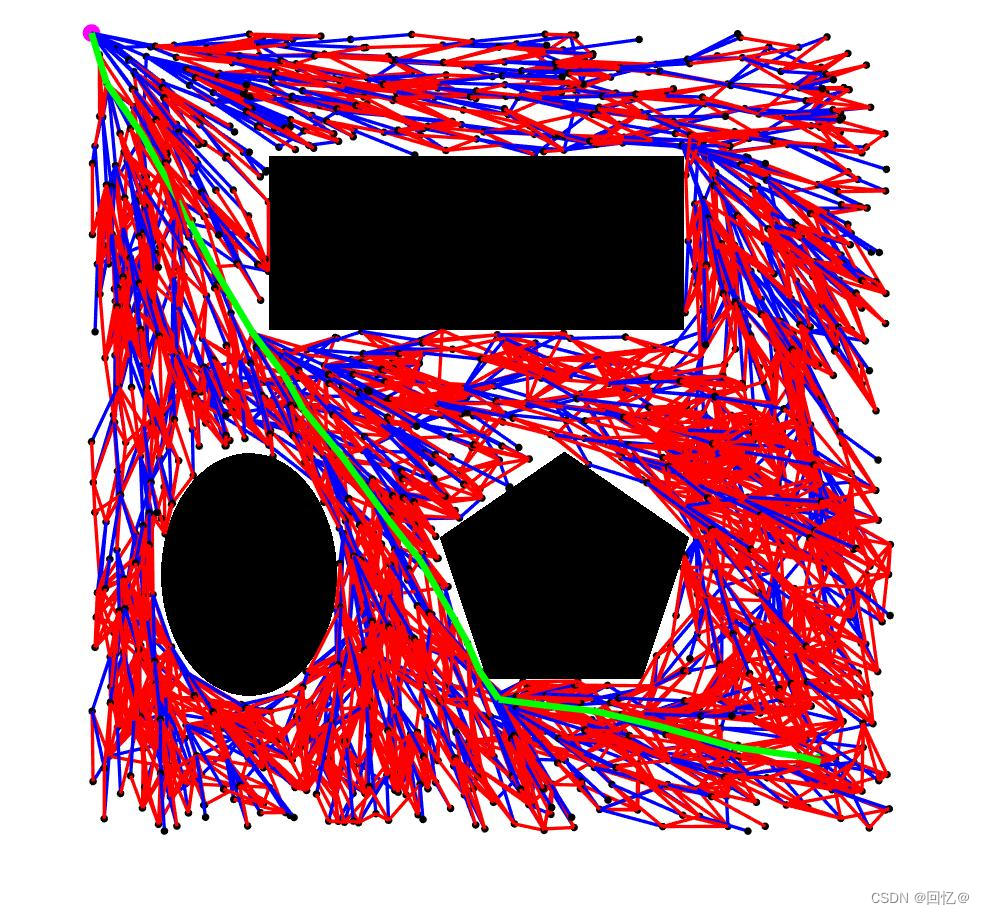RRTStar算法概述
RRTStar算法的主要特征是能快速的找出初始路径,之后随着采样点的增加,不断地进行优化直到找到目标点或者达到设定的最大循环次数。RRTStar算法是渐进优化的,也就是随着迭代次数的增加,得出的路径是越来越优化的,而且永远不可能在有限的时间中得出最优的路径。
MATLAB代码如下
链接:https://pan.baidu.com/s/1028q7QxFsPKjnJ5mURatWg
提取码:5ncl
RRTStar算法代码分析
1、RRTStar函数
clear all; close all; clc;
%% 参数初始化
x_I = 1; y_I = 1; % 设置初始点
x_G = 730; y_G = 730; % 设置目标点
GoalThreshold = 30; % 设置目标点阈值
Delta = 30; % 设置扩展步长 default:30
RadiusForNeib = 80; % rewire的范围,半径r
MaxIterations = 2500; % 最大迭代次数
UpdateTime = 50; % 更新路径的时间间隔
DelayTime = 0.0; % 绘图延迟时间
%% 建树初始化:T是树,v是节点
T.v(1).x = x_I; % 把起始节点加入到T中
T.v(1).y = y_I;
T.v(1).xPrev = x_I; % 节点的父节点坐标:起点的父节点是其本身
T.v(1).yPrev = y_I;
T.v(1).totalCost = 0; % 从起始节点开始的累计cost,这里取欧氏距离
T.v(1).indPrev = 0; % 父节点的索引
%% 开始构建树
figure(1);
ImpRgb = imread('map.png');
Imp = rgb2gray(ImpRgb);
imshow(Imp)
xL = size(Imp,1); % 地图x轴长度
yL = size(Imp,2); % 地图y轴长度
hold on
plot(x_I, y_I, 'mo', 'MarkerSize',10, 'MarkerFaceColor','m'); % 绘制起点和目标点
plot(x_G, y_G, 'go', 'MarkerSize',10, 'MarkerFaceColor','g');
count = 1;
pHandleList = [];
lHandleList = [];
resHandleList = [];
findPath = 0;
update_count = 0;
path.pos = [];
for iter = 1:MaxIterations
%Step 1: 在地图中随机采样一个点x_rand (Sample)
x_rand = [unifrnd(0,xL),unifrnd(0,yL)]; %产生随机点(x,y)
%Step 2: 遍历树,从树中找到最近邻近点x_near (Near)
minDis = sqrt((x_rand(1) - T.v(1).x)^2 + (x_rand(2) - T.v(1).y)^2);
minIndex = 1;
for i = 2:size(T.v,2) % T.v按行向量存储,size(T.v,2)获得节点总数
distance = sqrt((x_rand(1) - T.v(i).x)^2 + (x_rand(2) - T.v(i).y)^2); %两节点间距离
if(distance < minDis)
minDis = distance;
minIndex = i;
end
end
x_near(1) = T.v(minIndex).x; % 找到当前树中离x_rand最近的节点
x_near(2) = T.v(minIndex).y;
temp_parent = minIndex; % 临时父节点的索引
temp_cost = Delta + T.v(minIndex).totalCost; % 临时累计代价
%Step 3: 扩展得到x_new节点 (Steer)
theta = atan2((x_rand(2) - x_near(2)),(x_rand(1) - x_near(1)));
x_new(1) = x_near(1) + cos(theta) * Delta;
x_new(2) = x_near(2) + sin(theta) * Delta;
%plot(x_rand(1), x_rand(2), 'ro', 'MarkerSize',10, 'MarkerFaceColor','r');
%plot(x_new(1), x_new(2), 'bo', 'MarkerSize',10, 'MarkerFaceColor','b');
% 检查节点是否是collision-free
if ~collisionChecking(x_near,x_new,Imp)
continue; %有障碍物
end
%Step 4: 在以x_new为圆心,半径为R的圆内搜索节点 (NearC)
disToNewList = []; %每次循环要把队列清空
nearIndexList = [];
for index_near = 1:count
disTonew = sqrt((x_new(1) - T.v(index_near).x)^2 + (x_new(2) - T.v(index_near).y)^2);
if(disTonew < RadiusForNeib) % 满足条件:欧氏距离小于R
disToNewList = [disToNewList disTonew]; % 满足条件的所有节点到x_new的cost
nearIndexList = [nearIndexList index_near]; % 满足条件的所有节点基于树T的索引
end
end
%Step 5: 选择x_new的父节点,使x_new的累计cost最小 (ChooseParent)
for cost_index = 1:length(nearIndexList) % cost_index是基于disToNewList的索引,不是整棵树的索引
costToNew = disToNewList(cost_index) + T.v(nearIndexList(cost_index)).totalCost;
if(costToNew < temp_cost) % temp_cost为通过minDist节点的路径的cost
x_mincost(1) = T.v(nearIndexList(cost_index)).x; % 符合剪枝条件节点的坐标
x_mincost(2) = T.v(nearIndexList(cost_index)).y;
if ~collisionChecking(x_mincost,x_new,Imp)
continue; %有障碍物
end
temp_cost = costToNew;
temp_parent = nearIndexList(cost_index);
end
end
%Step 6: 将x_new插入树T (AddNodeEdge)
count = count+1; %最新节点的索引
T.v(count).x = x_new(1);
T.v(count).y = x_new(2);
T.v(count).xPrev = T.v(temp_parent).x;
T.v(count).yPrev = T.v(temp_parent).y;
T.v(count).totalCost = temp_cost;
T.v(count).indPrev = temp_parent; %其父节点x_near的index
l_handle = plot([T.v(count).xPrev, x_new(1)], [T.v(count).yPrev, x_new(2)], 'b', 'Linewidth', 2);
p_handle = plot(x_new(1), x_new(2), 'ko', 'MarkerSize', 4, 'MarkerFaceColor','k');
pHandleList = [pHandleList p_handle]; %绘图的句柄索引即为count
lHandleList = [lHandleList l_handle];
pause(DelayTime);
%Step 7: 剪枝 (rewire)
for rewire_index = 1:length(nearIndexList)
if(nearIndexList(rewire_index) ~= temp_parent) % 若不是之前计算的最小cost的节点
newCost = temp_cost + disToNewList(rewire_index); % 计算neib经过x_new再到起点的代价
if(newCost < T.v(nearIndexList(rewire_index)).totalCost) % 需要剪枝
x_neib(1) = T.v(nearIndexList(rewire_index)).x; % 符合剪枝条件节点的坐标
x_neib(2) = T.v(nearIndexList(rewire_index)).y;
if ~collisionChecking(x_neib,x_new,Imp)
continue; %有障碍物
end
T.v(nearIndexList(rewire_index)).xPrev = x_new(1); % 对该neighbor信息进行更新
T.v(nearIndexList(rewire_index)).yPrev = x_new(2);
T.v(nearIndexList(rewire_index)).totalCost = newCost;
T.v(nearIndexList(rewire_index)).indPrev = count; % x_new的索引
%delete(pHandleList());
%delete(lHandleList(nearIndexList(rewire_index)));
lHandleList(nearIndexList(rewire_index)) = plot([T.v(nearIndexList(rewire_index)).x, x_new(1)], [T.v(nearIndexList(rewire_index)).y, x_new(2)], 'r', 'Linewidth', 2);
%pHandleList = [pHandleList p_handle]; %绘图的句柄索引即为count
%lHandleList = [lHandleList l_handle];
end
end
end
%Step 8:检查是否到达目标点附近
disToGoal = sqrt((x_new(1) - x_G)^2 + (x_new(2) - y_G)^2);
if(disToGoal < GoalThreshold && ~findPath) % 找到目标点,此条件只进入一次
findPath = 1;
count = count+1; %手动将Goal加入到树中
Goal_index = count;
T.v(count).x = x_G;
T.v(count).y = y_G;
T.v(count).xPrev = x_new(1);
T.v(count).yPrev = x_new(2);
T.v(count).totalCost = T.v(count - 1).totalCost + disToGoal;
T.v(count).indPrev = count - 1; %其父节点x_near的index
end
if(findPath == 1)
update_count = update_count + 1;
if(update_count == UpdateTime)
update_count = 0;
j = 2;
path.pos(1).x = x_G;
path.pos(1).y = y_G;
pathIndex = T.v(Goal_index).indPrev;
while 1
path.pos(j).x = T.v(pathIndex).x;
path.pos(j).y = T.v(pathIndex).y;
pathIndex = T.v(pathIndex).indPrev; % 沿终点回溯到起点
if pathIndex == 0
break
end
j=j+1;
end
for delete_index = 1:length(resHandleList)
delete(resHandleList(delete_index));
end
for j = 2:length(path.pos)
res_handle = plot([path.pos(j).x; path.pos(j-1).x;], [path.pos(j).y; path.pos(j-1).y], 'g', 'Linewidth', 4);
resHandleList = [resHandleList res_handle];
end
end
end
pause(DelayTime); %暂停DelayTime s,使得RRT*扩展过程容易观察
end
for delete_index = 1:length(resHandleList)
delete(resHandleList(delete_index));
end
for j = 2:length(path.pos)
res_handle = plot([path.pos(j).x; path.pos(j-1).x;], [path.pos(j).y; path.pos(j-1).y], 'g', 'Linewidth', 4);
resHandleList = [resHandleList res_handle];
end
disp('The path is found!');
障碍物函数
function feasible=collisionChecking(startPose,goalPose,map)
feasible=true;
%dir=atan2(goalPose(1)-startPose(1),goalPose(2)-startPose(2));
dir = atan2(goalPose(2)-startPose(2),goalPose(1)-startPose(1));
for r = 0:0.5:sqrt(sum((startPose-goalPose).^2)) %以0.5为步长,从startPose开始递增的检查是否有障碍
%posCheck = startPose + r.*[sin(dir) cos(dir)]; %直线距离增加0.5后的坐标
posCheck = startPose + r.*[cos(dir) sin(dir)]; %直线距离增加0.5后的坐标
%将一个小数(x,y)向4个方向取整,确保该点没有触碰障碍
if ~(feasiblePoint(ceil(posCheck),map) && feasiblePoint(floor(posCheck),map) ...
&& feasiblePoint([ceil(posCheck(1)) floor(posCheck(2))],map) ...
&& feasiblePoint([floor(posCheck(1)) ceil(posCheck(2))],map))
feasible = false;
break;
end
if ~feasiblePoint([floor(goalPose(1)),ceil(goalPose(2))],map)
feasible = false;
end
end
function feasible = feasiblePoint(point,map)
feasible = true;
if ~(point(1)>=1 && point(1)<=size(map,1) && point(2)>=1 ...
&& point(2)<=size(map,2) && map(point(2),point(1))==255)
feasible = false; %有障碍
end
运算结果























 2658
2658











 被折叠的 条评论
为什么被折叠?
被折叠的 条评论
为什么被折叠?








